Show your active participation in breast cancer support with social activities raising awareness about the disease.
| Active Distributed Computing Projects - Life Sciences |
|
These links take you to other project categories on this site:
Mathematics Language Art Puzzles/Games Miscellaneous Distributed Human Projects Collaborative Knowledge Bases Charity See the bottom of this page for a description of the icons on the page. |
| Project Information | Project % Complete | Major Supported Platforms |
|---|---|---|
 Help
Compute Against Cancer fight
cancer. The project is supporting the following research projects:
Help
Compute Against Cancer fight
cancer. The project is supporting the following research projects:
The project runs on the Parabon Computation Frontier Compute Engine platform. To participate in the project, download and run the project's secure Java client. As of January 15, 2007, the client is available for Windows (XP/Vista/2000), Linux (2.4 kernel or higher), and Mac OSX (version 10.2 or later). |
unknown |
|
|
On October 21, 2002, the project announced that it achieved its initial goal: to "simulate the folding dynamics of proteins and make quantitative predictions for how [protein folding] works. This has been a 'holy grail' of computational biology." Specifically, the project simulated the folding of a man-made chain of 23 amino acids called BBA5. The simulation's measurements and folding-time matched physical measurements and folding-time of the protein observed in a lab. The achievement was published in the November, 2002, edition of Nature, in an article titled "Absolute comparison of simulated and experimental protein-folding dynamics." In October and November, 2004, the project's lead developer and research scientist, Guha Jayachandran, won the top award at the 2004 Biomedical Computation at Stanford (bcats) conference, and Vijay Pande has been named a 2004 Technovator. On January 10, 2003, the project broke the 90,000 active CPU mark. On October 10, 2003, it broke the 120,000 active CPU mark. On April 24, 2004, it broke the 150,000 active CPU mark. On September 9, 2004, it broke the 1,000,000 total CPUs and 100 TFLOPs marks. On January 14, 2005, it broke the 170,000 actuve CPU mark. On September 20, 2005, it broke the 200,000 active CPU mark. On November 28, 2001, the project began studies (110 and 5100) on Alzheimer's Disease. On May 8, 2002, the project began studies (503 and 504) on Huntington's Disease, a disease similar to Alzheimer's Disease in that it is caused by protein misfolding. See a list of all of the project's current studies. In June, 2002, the project started using the Gromacs molecular dynamics modeling software. This software allows the project to simulate larger proteins more accurately and much more quickly than the previous software. As of August 12, 2002, the Gromacs software has successfully modeled one of the simpler molecules, project 902, and shows a lot of promise for success with larger molecules. On March 27, 2003, the project began studying several new types or work units, including NTL9 (a protein with both beta and alpha structure) and 1PRB (a three-helix bundle). The project also increased the scope of its trpzip investigation to include a fourth variant trpzip4. On April 23, 2004, it published the first results from its Gromacs core. On August 20, 2004, the project began its P130x projects: these projects have work units much larger than normal, and require users to have hundreds of MB of RAM and be able to transfer 5 MB of data for each result, but the work units have 50% more value in stats. On October 12, 2004, the project released a new AMBER (Assisted Model Building with Energy Refinement) core which will allow it to do things that it can't with its existing Tinker and Gromacs cores. See the AMBER core FAQ. On January 15, 2005, the project published the results of its p53 tumor suppressor study, part of its cancer research project. These results are "the first peer-reviewed results from a distributed computing project related to cancer." On December 22, 2009, the project released a new core (Protomol core B4), which implements "the NML (Normal Mode Langevin) method" of protein folding simulation. If it is successful, this method could be up to one hundred times faster than previous cores. On September 18, 2008, the project released an updated version of its PlayStation 3 client, now included in a Life With PlayStation feature on the PlayStation 3 console, which does more complex scientific calculations and which displays a more detailed globe, with weather and news reports for major cities plus a real-time map of cloud cover over the globe. On February 18, 2009, the project passed the 5 PetaFLOPs mark. At that time traditional supercomputers were just passing the 1 PetaFLOPs mark. "The use of GPU's and Cell processors is has been key to this, and in fact the NVIDIA numbers alone have just passed 2 petaflops." On January 17, 2010, the project announced it successfully achieved the first protein folding simulation on a millisecond timescale. This achievement is 1,000 times more difficult than the project's initial goal of simulation millisecond timescale simulation. The project published its 72d paper, Molecular Simulation of ab Initio Protein Folding for a Millisecond Folder NTL9(1-39), about the achievement. On June 27, 2010, the project published a paper, "Atomic-Resolution Simulations Predict a Transition State for Vesicle Fusion Defined by Contact of a Few Lipid Tails," describing the project's "work on the mechanism for vesicle fusion," an important part of the process in which a virus infects a cell. Learning about this mechanism will help scientists better understand how the influenza virus enters cells. On November 18, 2011, the project owners announced they have developed the new Copernicus framework to utilize supercomputers efficiently for protein folding simulations. On February 27, 2020, the project began research into the COVID-19 coronavirus, which caused a worldwide pandemic. "2019-nCoV is a close cousin to SARS coronavirus (SARS-CoV), and acts in a similar way." Version 7.6.13 of the client is available for Windows, Linux and Mac OSX as of April 17, 2020. It allows volunteers to prioritize COVID-19 projects. Students and teachers should see the Education@Home section of the site. See the research papers and articles published from the results of this project. See Professor Pande's February 19, 2004, talk at Xerox PARC: Folding@Home: Can a grid of 100,000 CPUs tackle fundamental barriers in molecular simulation? Windows Media Player is required to view the video. See independently-maintained hourly team and user stats for this project at statsman.org. See an independent support site for helpful hints about participating in this project. See the original Folding@Home project. Join a discussion forum about this project. Join a discussion forum about the original project. Join an independent discussion forum about ab-initio protein folding (where the folding is simulated completely in software) To participate in the project, follow the instructions on the project website to download and install the software client application. To participate in the project with your Chrome web browser, read information about the browser application, then open this URL in your Chrome browser: http://folding.stanford.edu/nacl/. The software client automatically downloads and then runs until you close the browser. |
ongoing |
 PS3 |
 Help design new drugs to fight
AIDS at
fightAIDS@home. The project is sponsored by the non-profit
Scripps Research Institute. The project
website site is also available in Chinese
Help design new drugs to fight
AIDS at
fightAIDS@home. The project is sponsored by the non-profit
Scripps Research Institute. The project
website site is also available in Chinese
The project completed Phase I on May 21, 2003 (in this phase, almost 60,000 computers completed 1,400 years of computing to process over 9 million tasks). "[Phase I] has ably demonstrated that with such massive computational abilities, researchers can utilize intensive approaches to identify drug candidates that succumb to resistance mutations and those that are more resilient to such mutations. An early lead developed during Phase I, TL-3, has been shown to be promising against the drug resistant strains that have arisen from the currently approved HIV Protease inhibitors. The characteristics of TL-3 have been born out by the FAAH computational work." The project began
Phase II on May 21, 2003. Note that for Phase II, the project transfered
completely to The Scripps Research Institute (and became a completely
non-profit project) and Entropia is no
longer involved. You will need to reregister and download a new client to
participate in Phase II. You can learn more about the project through
articles it published on January 19 and January 26, 2004:
On February 3, 2010, the project announced it found two compounds that make a completely new class of AIDS-fighting drugs possible: "two compounds that act on novel binding sites for an enzyme used by the human immunodeficiency virus (HIV), the virus that causes AIDS. The discovery lays the foundation for the development of a new class of anti-HIV drugs to enhance existing therapies, treat drug-resistant strains of the disease, and slow the evolution of drug resistance in the virus." The project began Experiment 33 on June 3, 2010 and completed it on December 1, 2010. This was the first experiment to target the HIV integrase system. The experiment screened over 360,000 protein fragments and some larger compounds "against our new dynamic models of the E92Q/N155H drug-resistant mutant of HIV-1 integrase," searching for compounds which can attach to brand new binding sites on this mutant. The project began Experiment 34 on October 11, 2010. It is the second experiment which targets the HIV integrase system. The experiment is "screening the 'full National Cancer Institute's (NCI) library' of over 315,000 different compounds against our new dynamic models of the wild type, the G140S/Q148H drug-resistant mutant, and the E92Q/N155H drug-resistant mutant of HIV-1 integrase. We are trying to discover compounds that can bind to and inhibit the active site of the wild type and these two drug-resistant mutants." The project began Experiment 35 on November 26, 2010. This project involves "involves screening the full NCI library of ~ 316,000 compounds against the active site of 8 different versions of HIV protease." It is similar to Experiment 32, "but a different library of compounds is being screened, and one new target has been added." The project published Volume 10 of its newsletter on October 21, 2011. Dr. Alex Perryman of the project also created a YouTube video clip which gives a general summary of the project. Newsletter Volume 12 waspublished on November 18, 2013. On November 19, 2005, the project joined the World Community Grid. The original software client is not supported as of that date. Users of the original client can follow easy migration instructions to move to the World Community Grid client, and World Community Grid participants can follow the directions on the new download page to ensure their client is participating in fightAIDS@home. A BOINC client for Linux should be available soon. |
97,736,624 results returned; experiment 5: 50% |
|
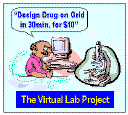 Help screen molecules to design drugs to fight diseases
in The Virtual
Laboratory Project. This project does not work in the way that traditional
projects do. Instead of downloading a software client and
having it get work assignments, you set up Globus
grid computing software on your system and then
make your
system available to the World Wide Grid (WWG), a global computing grid.
Then the Virtual Lab project coordinators can schedule computations on your
system at their convenience. Because of this setup, this project is best for
users with permanent Internet connections. For this project, the
coordinators use their grid scheduler, called Nimrod-G, to deploy their
Nimrod-G agents on your machine to do the molecule screening. Their view of
the project looks like
this.
Help screen molecules to design drugs to fight diseases
in The Virtual
Laboratory Project. This project does not work in the way that traditional
projects do. Instead of downloading a software client and
having it get work assignments, you set up Globus
grid computing software on your system and then
make your
system available to the World Wide Grid (WWG), a global computing grid.
Then the Virtual Lab project coordinators can schedule computations on your
system at their convenience. Because of this setup, this project is best for
users with permanent Internet connections. For this project, the
coordinators use their grid scheduler, called Nimrod-G, to deploy their
Nimrod-G agents on your machine to do the molecule screening. Their view of
the project looks like
this.
See a white paper about this process: The Virtual Laboratory: Enabling Molecular Modeling, and a PhD thesis. The biology collaborator working on this project has already designed a drug to counteract an ECE enzyme involved in heart stroke, and is currently using the Virtual Laboratory to study liver cancer. See another white paper by the project coordinators: Grids and Grid Technologies for Wide-Area Distributed Computing. Note: this project is currently only for Linux/Unix users. Windows is not supported yet. |
ongoing |
|
|
The project's results database was first accessed by researchers on September 26, 2005. The project uses the BOINC computing platform to run various applications. See the BOINC platform information for the latest version of the BOINC client. If you already have BOINC installed, you can join this and other World Community Grid BOINC-based projects by attaching to the project URL www.worldcommunitygrid.org. You can select/de-select World Community Grid projects in your World Community Grid member page, under My Grid --> My Projects. This project is discussed in the World Community Grid forums. |
26,044,374 results returned |
|
 Help
Rosetta@home "predict and
design protein structures, and protein-protein and protein-ligand
interactions," in order to "develop methods that accurately predict and
design protein structures and complexes, an endeavor that may ultimately help
researchers develop cures for human diseases such as cancer, HIV/AIDS, and
malaria." This project, run by
The Baker Laboratory at the University
of Washington, will help the lab improve its Rosetta software package, which
is used by other projects such as
Human Proteome Folding. The project published its
latest Science News
update on January 27, 2006. On March 20, 2008, the project successfully
created two functional enzymes not found in nature. Designed enzymes could
be used in the future to produce pharmaceuticals and fuel. On March 11, 2013,
the project announced it discovered a new class of proteins that can be used
as antidotes for drug overdoses and in sensors. On February 24, 2020, the
project began research into the COVID-19
coronavirus,
which caused a worldwide pandemic.
Help
Rosetta@home "predict and
design protein structures, and protein-protein and protein-ligand
interactions," in order to "develop methods that accurately predict and
design protein structures and complexes, an endeavor that may ultimately help
researchers develop cures for human diseases such as cancer, HIV/AIDS, and
malaria." This project, run by
The Baker Laboratory at the University
of Washington, will help the lab improve its Rosetta software package, which
is used by other projects such as
Human Proteome Folding. The project published its
latest Science News
update on January 27, 2006. On March 20, 2008, the project successfully
created two functional enzymes not found in nature. Designed enzymes could
be used in the future to produce pharmaceuticals and fuel. On March 11, 2013,
the project announced it discovered a new class of proteins that can be used
as antidotes for drug overdoses and in sensors. On February 24, 2020, the
project began research into the COVID-19
coronavirus,
which caused a worldwide pandemic.
The project uses the BOINC computing platform. See the BOINC platform information for the latest version of the BOINC client. The BOINC client is available for Windows, Linux and Mac OSX. Version 5.25 of the Rosetta application is available for Windows, Linux and Mac OSX as of June 20, 2006. See a 7 minute YouTube video about the project. The video was created on January 7, 2007. Join a discussion forum about the project. |
ongoing; 8,262,355,343 credits |
|
 Help
RALPH@home test new application
versions, work unit types, and other updates for
Rosetta@home. This testing improves
Rosetta@home.
Help
RALPH@home test new application
versions, work unit types, and other updates for
Rosetta@home. This testing improves
Rosetta@home.
The project uses the BOINC computing platform. See the BOINC platform information for the latest version of the BOINC client. The BOINC client is available for Windows, Linux and Mac OSX. Join a discussion forum about the project. |
ongoing; 27,649,840 credits |
|
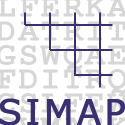 Help
SIMAP compute
similarities between all known protein sequences.
"SIMAP is short for
Similarity Matrix of Proteins. SIMAP is a database for the precomputed
homologies of protein sequences and provides specialized retrieval tools for
effective use of that data. The publicly available web based SIMAP
presentation module provides various search tools." See a
more detailed description of the project.
Help
SIMAP compute
similarities between all known protein sequences.
"SIMAP is short for
Similarity Matrix of Proteins. SIMAP is a database for the precomputed
homologies of protein sequences and provides specialized retrieval tools for
effective use of that data. The publicly available web based SIMAP
presentation module provides various search tools." See a
more detailed description of the project.
The project had over 10,000 hosts and 5,000 users with credits, and has calculated the similarities for more than 1 million protein sequences, as of March 22, 2006. The project uses the BOINC computing platform. See the BOINC platform information for the latest version of the BOINC client. Version 5.11 of the SIMAP application is available for Linux as of July 17, 2006. Version 5.10 is available for Windows and Mac OSX as of July 12, 2006. Versions 5.6 and later reduce the calculation time per work unit to 1/10th that of previous versions. Dialup users should be aware that work units are about 1.5 MB and results are about 1.3 MB. Join a discussion forum about this project. |
ongoing; 654,667,609 credits |
|
 Help
malariacontrol.net simulate
the ways that the malaria parasite (Plasmodium falciparum malaria)
spreads in Africa, and its effects on human health. The models it creates
will help scientists and doctors "determine optimal strategies for
delivering mosquito nets, chemotherapy, or new vaccines which are currently
under development and testing." This project is part of the
Africa@home project.
Help
malariacontrol.net simulate
the ways that the malaria parasite (Plasmodium falciparum malaria)
spreads in Africa, and its effects on human health. The models it creates
will help scientists and doctors "determine optimal strategies for
delivering mosquito nets, chemotherapy, or new vaccines which are currently
under development and testing." This project is part of the
Africa@home project.
On September 17, 2007, the project began testing a third science application called optimizer. This application is run as a test application, "meaning that only users who have 'run test applications' and 'run optimizer application' checked in their account settings (under malariacontrol.net preferences) will get work, and only Windows users will get work. Results from the optimizer application are helping the project team "to improve the main malariacontrol application in the future." As of March 1, 2010, the project is preparing new work units for its next phase of research. In October, 2008, the project published its first results, a paper titled What Should Vaccine Developers Ask? Simulation of the Effectiveness of Malaria Vaccines. The project uses the BOINC computing platform to run various applications. See the BOINC platform information for the latest version of the BOINC client. See the project's Applications page for a list of the project's current applications and versions. Join a discussion forum about this project. |
ongoing; 581,696,570 credits |
|

Note: The project's server accidentally went down on August 18, 2008. The project team is repairing the server. The project is on hold in the meantime. The project uses a BOINC-based client. See the BOINC platform information for the latest version of the BOINC client. Version 5.99 of the BD client is available for Windows, Linux and Mac OSX as of October 1, 2007. |
on hold |
|
|
The project's first research project was "complex 1HVI: the Hiv-1 protease complexed with the inhibitor A77003." On September 10, 2008, it began researching "model 13sc. This model keeps track of the ligand structure, enabling the study of initial conditions in our simulations." The project began its public Beta test on September 3, 2008, and opened public account registration on September 8, 2008. The project uses a BOINC-based client. See the BOINC platform information for the latest version of the BOINC client. The project is currently in Beta testing. See the project's Applications page for a list of the project's current applications and versions. Join a discussion forum about this project. |
ongoing; 385,326,191 credits |
|
 Help
proteins@home
solve the "inverse protein folding problem" (enumerating the allowed
sequences for a given fold) for a large number of known protein folds.
The project is studying a representative subset of about 1,500 folds. See
more information
about the project.
Help
proteins@home
solve the "inverse protein folding problem" (enumerating the allowed
sequences for a given fold) for a large number of known protein folds.
The project is studying a representative subset of about 1,500 folds. See
more information
about the project.
The project team published its first paper, "Computational protein design: Software implementation, parameter optimization, and performance of a simple model," on December 10, 2007. The project uses a BOINC-based client. See the BOINC platform information for the latest version of the BOINC client. The project is currently in Alpha testing. Version 7.41 of the Xplor client is available for Windows as of February 1, 2008. Join a discussion forum about this project. |
ongoing; credits |
|
|
Phase 1 of the project performed cross-docking calculations on over 150 proteins, to see how well each protein iteracts with each of the other proteins. See more information about Phase 1. This phase ended on June 11, 2007. In the 7 months that Phase 1 ran, "106,000 members will have donated more than 8,000 years of computer time on 154,000 different computers," and computed 5,416,082 results. Phase 2 should begin in 2008. Phase 2 began in May, 2009. It is "investigating protein-protein interactions for more than 2,200 proteins whose structures are known, with particular focus on those proteins that play a role in neuromuscular diseases." See more information about Phase 2. Phase 2 is ending in October, 2012. As of January 9, 2013, the project has captured all of the possible molecular and atomic connections among 2,280 human proteins "known to mutate and induce different forms of neuromuscular disorders, including Muscular Dystrophy." See the project's Phase 1 FAQ and Phase 2 FAQ. The project uses the World Community Grid computing platform. Participants are encouraged to participate through World Community Grid. See World Community Grid platform information for the latest version of these platform clients. The clients are currently available for Windows, Linux and Mac OSX. Please review the clients' system requirements. Join a discussion forum about World Community Grid's projects. |
5,416,082 results returned for Phase 1; 32,225,585 results returned for Phase 2 |
|
|
The project completed Phase 1 (a screening process for over 3 million potential drug molecules) on August 26, 2009. Project participants contributed over 12,000 years of computing time to Phase 1. The results of Phase 1 benefit research not only for Dengue Fever but also for Hepatitis C, West Nile, Yellow Fever and other diseases caused by the Flaviviridea family of viruses. Phase 2 will perform more in-depth analysis on the best candidates found in Phase 1. The best candidates found in Phase 2 will be tested in labs. The project began Phase 2 on March 23, 2010. This phase is reducing the number of "false positive" (i.e. dead end) results from phase 1. On November 10, 2014, the project announced it found a promising drug candidate that has the potential to prevent the virus from replicating. It may also disable similar flaviviruses like West Nile virus. The project uses the BOINC computing platform to run various applications. See the BOINC platform information for the latest version of the BOINC client. If you already have BOINC installed, you can join this and other World Community Grid BOINC-based projects by attaching to the project URL www.worldcommunitygrid.org. You can select/de-select World Community Grid projects in your World Community Grid member page, under My Grid --> My Projects. This project is discussed in the World Community Grid forums. |
25,609,575 results returned |
|
|
The project uses a BOINC-based client. See the BOINC platform information for the latest version of the BOINC client. Versions 5.09, 5.10, 5.11 and 5.12 of the GARLI client are available for Windows, Linux and Mac OSX as of December 18, 2007. Version 5.05, 5.06 and 5.10 of the HMMPfam client are available for Windows, Linux and Mac OSX as of December 18, 2007. Version 5.02 of the MARXAN client is available for Windows as of December 18, 2007. Join a discussion forum about this project. |
ongoing; 56,890,702 credits |
|
This project participated in the CASP8 protein structure prediction contest, which occured between May 5, 2008 and August 1, 2008. Results from the contest were released at the CASP meeting on December 3-7, 2008, and were published at PlanetBOINC. The project uses a BOINC-based client. See the BOINC platform information for the latest version of the BOINC client. Versions 0.07 of the POEM Protein Folding application is available for Windows as of November 29, 2007. Version 0.08 is available for Linux and Mac OS X as of January 11, 2008. Join a discussion forum about this project. |
ongoing; 850,873,361 credits |
|
|
As of June 15, 2010, the project has sifted through more than 100 million images of 12,500 unique proteins which may be linked to cancer. These pictures were taken during 19.2 million experiments. This project allows scientists to get results six times faster than by using traditional methods. The project uses the BOINC computing platform to run various applications. See the BOINC platform information for the latest version of the BOINC client. If you already have BOINC installed, you can join this and other World Community Grid BOINC-based projects by attaching to the project URL www.worldcommunitygrid.org. You can select/de-select World Community Grid projects in your World Community Grid member page, under My Grid --> My Projects. This project is discussed in the World Community Grid forums. |
52,485,470 results returned |
|
|
Help
Cels@Home "do research
in cell adhesion. One of the many applications of this is in cancer research,
as the point at which cancerous cells quit staying in place, and instead break
free to move throughout the body, is a critical event that makes the disease
much harder to treat."
The project uses a BOINC-based client. See the BOINC platform information for the latest version of the BOINC client. Versions 1.00 of the Cels@Home application is available for Windows as of February 25, 2008. Join a discussion forum about this project. |
ongoing; 19,257,730 credits |
|
 Help
MindModeling@Home use
"computational cognitive process modeling to better understand the human mind."
The project hopes to "improve on the scientific foundations that explain the
mechanisms and processes that enable and moderate human performance and
learning." The project is not yet active as of April 2, 2008, but participants
can help beta test it.
Help
MindModeling@Home use
"computational cognitive process modeling to better understand the human mind."
The project hopes to "improve on the scientific foundations that explain the
mechanisms and processes that enable and moderate human performance and
learning." The project is not yet active as of April 2, 2008, but participants
can help beta test it.
The project uses a BOINC-based client. See the BOINC platform information for the latest version of the BOINC client. Versions 3.00 of the project's client application is available for Windows, Linux and Mac OS X as of March 5, 2008. Join a discussion forum about this project. Join a discussion forum about the beta test project. |
ongoing; 17,589,036 credits |
|
|
Help
UCT : malariacontrol.net
test the correct operation of the malariacontrol.net
server for future BOINC-based projects. This project is a test project in
collaboration with malariacontrol.net.
This project is in a test mode. Participation is currently limited to a
few hundred participants.
The project uses a BOINC-based client. See the BOINC platform information for the latest version of the BOINC client. Versions 5.57 of the project's malariacontrol client application is available for Windows and Linux as of April 17, 2008. Join a discussion forum about this project. |
ongoing; 17,616,564,009 credits |
|
|
The project uses the BOINC computing platform to run various applications. See the BOINC platform information for the latest version of the BOINC client. If you already have BOINC installed, you can join this and other World Community Grid BOINC-based project by attaching to the project URL www.worldcommunitygrid.org. You can select/de-select World Community Grid projects in your World Community Grid member page, under My Grid --> My Projects. This project is discussed in the World Community Grid forums. |
73,581,917 results returned |
|
|
The project uses the BOINC computing platform to run various applications. See the BOINC platform information for the latest version of the BOINC client. If you already have BOINC installed, you can join this and other World Community Grid BOINC-based project by attaching to the project URL www.worldcommunitygrid.org. You can select/de-select World Community Grid projects in your World Community Grid member page, under My Grid --> My Projects. This project is discussed in the World Community Grid forums. |
3,848,181 results returned |
|
|
Help
DrugDiscovery@Home "model
the behavior of leading compounds that could be developed into new medicines."
The project "is in an early alpha phase and does not have a formal relationship with academia or the pharmaceutical industry."
The project uses a BOINC-based client. See the BOINC platform information for the latest version of the BOINC client. See the project's applications page for a list of its clients, their latest versions, and the platforms they are available for. Join a discussion forum about this project. |
ongoing; unknown credits |
|
|
Help DNA@Home "discover what regulates the genes in Deoxyribonucleic Acid (DNA). This project, based at
Rensselaer Polytechnic Institute, uses
statisical algorithms to find out how certain genes (sections of DNA) are
turned on and off during transcription, the process in which proteins are
created from DNA code.
The project's first task is to study the Mycobacterium Tuberculosis genome. Understanding how the genome makes the tuberculosis disease work will allow scientists to stop the disease more effectively. The project also plans to study Yersinia pestis, the cause of bubonic plague. The project uses a BOINC-based client. See the BOINC platform information for the latest version of the BOINC client. The project's "Gibbs sampler" client is available for Windows, Linux and Mac OSX. Join a discussion forum about this project. |
ongoing; unknown credits |
|
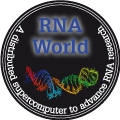 Help RNA World study Ribonucleic Acid
(RNA). The project's goal is
to "identify, analyze, structurally predict and design RNA molecules on the
basis of established bioinformatics software in a high-performance,
high-throughput fashion." See more information
about the project.
Help RNA World study Ribonucleic Acid
(RNA). The project's goal is
to "identify, analyze, structurally predict and design RNA molecules on the
basis of established bioinformatics software in a high-performance,
high-throughput fashion." See more information
about the project.
The project's first goal is to systematically identify all known RNA family members in all organisms currently known and to make the information available to the public. The project will also run sub-projects submitted by RNA researchers. The project uses a BOINC-based client. See the BOINC platform information for the latest version of the BOINC client. Join a discussion forum about this project. |
ongoing; unknown credits |
|
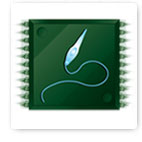
The project uses the BOINC computing platform to run various applications. See the BOINC platform information for the latest version of the BOINC client. If you already have BOINC installed, you can join this and other World Community Grid BOINC-based project by attaching to the project URL www.worldcommunitygrid.org. You can select/de-select World Community Grid projects in your World Community Grid member page, under My Grid --> My Projects. This project is discussed in the World Community Grid forums. |
3,548,846 results returned |
|
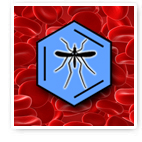
The project published a project update on July 14, 2014. Part 1 of the project completed 1.16 billion docking calculations (the first distributed computing project to complete over 1 billion docking calculations) and tested 5.6 million potential drug compounds against 22 different malaria drug targets ("and against some targets for treating drug-resistant tuberculosis, Methicillin-Resistant Staphylococcus aureus (MRSA), filariasis, and bubonic plague, when the targets from those other pathogens had structural similarity to the targets from malaria"). The projhect posted an update on February 11, 2015. The project uses the BOINC computing platform to run various applications. See the BOINC platform information for the latest version of the BOINC client. If you already have BOINC installed, you can join this and other World Community Grid BOINC-based project by attaching to the project URL www.worldcommunitygrid.org. You can select/de-select World Community Grid projects in your World Community Grid member page, under My Grid --> My Projects. This project is discussed in the World Community Grid forums. |
unknown results returned |
|
|
Help
Social Docking
find potential drugs to treat Alzheimer's
and AIDS. This project
"is the first attempt ever to attempt virtual screening of Massive Compound
Libraries entirely using JavaScript." The script "runs a Metropolis
Monte Carlo
Search with the ligand constrained to a binding site in the target. Enthalpy
is calculated using the General Amber Force Field and Entropy is considered by
taking the average of the Boltzmann distribution (how well the ligand 'tumbles
down' the energy hypersurface)."
To participate in the project, open the project's URL in your HTML5-enabled web browser. The project runs a script in the background when you leave the web page open in your browser (you can view other web pages in other tabs) and exits the script when you exit the project web page. The script completes one work unit (a test of one ligand against three receptors) in about 10 minutes. Note: after a few minutes your web browser may display a message saying that a script is taking to long to complete and asking if you want to allow the script to run or to stop the script. Allow the script to run. The project is the first to make use of HTML5 web workers (long-running scripts that run in the background and are not interrupted by user-interface scripts or user inputs). It also uses XmlHttpRequest level 2 (Cross-Origin Resource Sharing (CORS)) and WebGL math libraries. |
ongoing |
|
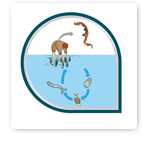
As of October 22, 2012, ten compounds discovered by the project are being tested in vitro (in a lab) and 16 more potential compounds are being evaluated for testing. The most promising candidate is a compound based on Digoxin. The project coordinators also participated in the 13th International Symposium on Schistosomiasis. The project uses the BOINC computing platform to run various applications. See the BOINC platform information for the latest version of the BOINC client. If you already have BOINC installed, you can join this and other World Community Grid BOINC-based project by attaching to the project URL www.worldcommunitygrid.org. You can select/de-select World Community Grid projects in your World Community Grid member page, under My Grid --> My Projects. See the system requirements for each project. This project is discussed in the World Community Grid forums. |
12,109,506 results returned |
|
|
The project uses a BOINC-based client. See the BOINC platform information for the latest version of the BOINC client. |
ongoing; unknown credits |
|
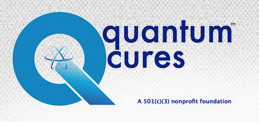 Help Quantum Cures
discover potential drugs to fight "orphan" or rare diseases currently ignored
by the pharmaceutical indistry. See more information
about the project.
Help Quantum Cures
discover potential drugs to fight "orphan" or rare diseases currently ignored
by the pharmaceutical indistry. See more information
about the project.
Note: As of March 1, 2013, this project is in development and is not currently active. The project is creating a client application to run on computers, tablets and smartphones around the world. |
not yet active |
|
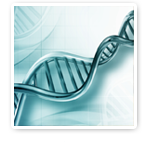
The project completed its first phase, a benchmark phase, on July 10, 2014. It processed over 26 million gene signatures to set a benchmark for future phases. The second phase will search for clinically useful molecular signatures, focusing on gene signatures that can predict the occurrence of various types of cancer. The project posted an update on February 12, 2015. The project uses the BOINC computing platform to run various applications. See the BOINC platform information for the latest version of the BOINC client. If you already have BOINC installed, you can join this and other World Community Grid BOINC-based project by attaching to the project URL www.worldcommunitygrid.org. You can select/de-select World Community Grid projects in your World Community Grid member page, under My Grid --> My Projects. See the system requirements for each project. This project is discussed in the World Community Grid forums. |
3,604,447 results returned |
|
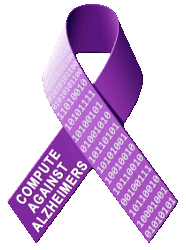 Help
Compute Against Alzheimer's Disease fight
Alzheimer's Disease, "a leading cause of death and dementia among the elderly, affecting
nearly 40 million people worldwide. In addition to its devastating effect on
patients and its emotional toll on their families, the societal costs of AD
are estimated to be in the hundreds of billions of dollars, yet there are no
effective treatment options available today." This project will investigate
specific aspects of the disease to help find better treatments and possibly
a cure for it. See the project's
FAQ and its
blog.
Help
Compute Against Alzheimer's Disease fight
Alzheimer's Disease, "a leading cause of death and dementia among the elderly, affecting
nearly 40 million people worldwide. In addition to its devastating effect on
patients and its emotional toll on their families, the societal costs of AD
are estimated to be in the hundreds of billions of dollars, yet there are no
effective treatment options available today." This project will investigate
specific aspects of the disease to help find better treatments and possibly
a cure for it. See the project's
FAQ and its
blog.
The
project is supporting the following research projects:
The project runs on the Parabon Computation Frontier Compute Engine platform. To participate in the project, download and run the project's secure Java client. As of June 6, 2014, the client is available for Windows (XP/Vista/7/8), Linux (2.4 kernel or higher), and Mac OSX (version 10.6 or later). Note that the project's client application is very resource-intensive. You can configure it to run at the same time you are using your computer but it will probably make the computer run very slowly for you. It is best to configure it to run only when you are not using the computer and when you are not running any other distributed computing project client applications. |
unknown |
|
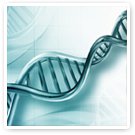
The project posted an update on February 26, 2015. As of November, 2017, the project owners are analyzing 30 Terabytes of data produced by the project. The project uses the BOINC computing platform to run various applications. See the BOINC platform information for the latest version of the BOINC client. If you already have BOINC installed, you can join this and other World Community Grid BOINC-based project by attaching to the project URL www.worldcommunitygrid.org. You can select/de-select World Community Grid projects in your World Community Grid member page, under My Grid --> My Projects. See the system requirements for each project. This project is discussed in the World Community Grid forums. |
1,101,080 results returned |
|
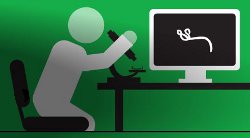
The project uses the BOINC computing platform to run various applications. See the BOINC platform information for the latest version of the BOINC client. If you already have BOINC installed, you can join this and other World Community Grid BOINC-based project by attaching to the project URL www.worldcommunitygrid.org. You can select/de-select World Community Grid projects in your World Community Grid member page, under My Grid --> My Projects. See the system requirements for each project. This project is discussed in the World Community Grid forums. |
3,999,644 results returned |
|
|
Help FiND@Home (Fight Neglected Diseases at Home), discover potential drugs to fight malaria and other diseases neglected by pharmaceutical companies. This project began as FightMalaria@Home: on January 6, 2015 it expanded to fight other diseases. See the project's FAQ. Results from FightMalaria@Home (as of January 6, 2015): "We have made a results website for easy access to the data we generated using the FM@H BOINC server. The first 400 MMV compounds (MalariaBox) data is available here: http://chemware.ucd.ie/FiNDaH/Malaria.php. The project uses the BOINC computing platform to run various applications. See the BOINC platform information for the latest version of the BOINC client. See the project's Applications page for a list of its current applications and versions. Join this project's discussion forum. |
ongoing; unknown credits |
|
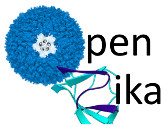
The project published a paper about its initial results on October 20, 2016. The project uses the BOINC computing platform to run various applications. See the BOINC platform information for the latest version of the BOINC client. If you already have BOINC installed, you can join this and other World Community Grid BOINC-based project by attaching to the project URL www.worldcommunitygrid.org. You can select/de-select World Community Grid projects in your World Community Grid member page, under My Grid --> My Projects. See the system requirements for each project. This project is discussed in the World Community Grid forums. |
23,157,396 results returned |
|

On May 14, 2020, the project started looking for treatments for the COVID-19 disease caused by the SARS-CoV2 coronavirus, which caused a worldwide pandemic. The project uses the BOINC computing platform to run various applications. See the BOINC platform information for the latest version of the BOINC client. If you already have BOINC installed, you can join this and other World Community Grid BOINC-based projects by attaching to the project URL www.worldcommunitygrid.org. You can select/de-select World Community Grid projects in your World Community Grid member page, under My Grid --> My Projects. See the system requirements for each project. This project is discussed in the World Community Grid forums. |
0 results returned |
|
| The following icons may appear in the Supported Platforms section of the table: | |||||||||||||
|
| Top... |